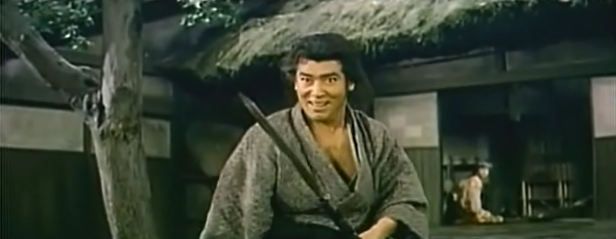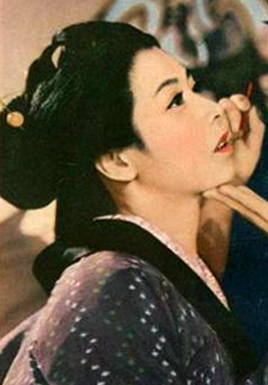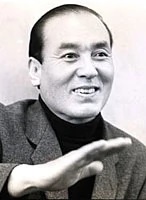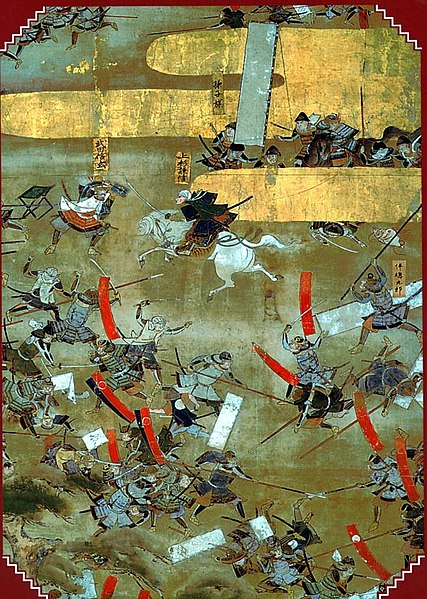Physical Address
304 North Cardinal St.
Dorchester Center, MA 02124

Alternate Titles: Wine, Women and Spear (literal title)1; The Drunken Spearman; A Man’s Ambition
| Production Company | Toei Kyoto |
| Scenarist | Ide Masato |
| Source | Kaionji Chōgorō (story) |
| Cinematographer | Washio Motoya |
| Art Director | Suzuki Takatoshi |
| Music | Kosugi Taiichirō |
| Editing | Miyamoto Shintarō |
| Performers | Ōtomo Ryūtarō (Tomita Takasada, known as Kurando); Awashima Chikage (Murayama Sakon, an actress); Hanazono Hiromi (Umeme, her pupil, later Kurando’s wife); Kataoka Chiezō (Maeda Toshinaga); Kurokawa Yatarō (Toyotomi Hidetsugu, Kurando’s daimyō); Yamagata Isao (Ishida Mitsunari); Hara Kensaku (Tomita Kazunobu, Kurando’s older brother) Tōno Eijirō (Toyotomi Hideyoshi, the Great Regent); Ozawa Eitarō (Tokugawa Ieyasu) |
| Status | Extant |
| Photography | Color |
| Format | 35mm |
| Ratio | 2.35 : 1 |
| English subtitles | Yes |
| Original Release Date | May 15, 1960 |
| Length | 99 minutes |
| Awards and festival/retrospective screenings | MOMA Retrospective, 2016; IFFR (International Film Festival Rotterdam) 2005 |
During the late 16th Century, following a major battle in the long Japanese civil war, the hard-drinking samurai Tomita Takasada, nicknamed “Kurando,”2 is praised by his superiors for his skill as a master spearman. Afterwards, at a celebration for the most powerful warlord in Japan, the Great Regent (Taikō) Toyotomi Hideyoshi, Kurando joyfully performs a spear dance. Interrupting the performance, numerous retainers suddenly enter the scene and uncover crates filled with illegal rifles. The Great Regent’s nephew and former heir, Hidetsugu, who is falsely accused of ownership of these guns (actually planted by Hideyoshi) and of other trumped-up charges, is convicted of treason and is ordered to commit ritual suicide.
Since Hidetsugu was Kurando’s daimyō, under normal circumstances he would be expected to follow his master and commit suicide as well. But without telling him why, Hideyoshi has informally forbidden him to do so, much to Kurando’s frustration. Meanwhile, Mitsunari, an advisor to Hideyoshi, persuades the paranoid Great Regent to execute 38 members of his deceased nephew’s family, including over 30 women and children – even though only three of them have been exposed as spies. This massacre shocks everyone and turns public opinion against Hideyoshi and the whole Toyotomi clan.
Meanwhile, the Tomita clan, headed by Kurando’s brother, Kazunobu, holds a conference with Kurando in which they rebuke him for dishonoring them all by failing to kill himself, though he’d been ordered not to. Disgusted, Kurando stalks off. He then announces through a public notice that he will commit ritual suicide at the One Thousand Pines forest on the afternoon of the 28th of the month.
Determined to enjoy himself during his last days, he hires a young actress, Umeme, to dance for him and serve him wine. However, the leading actress of the troupe, her beloved mentor Murayama Sakon, refuses to allow Umeme to spend the night alone with Kurando, and she sleeps by the younger woman’s side to protect her. After Kurando finally convinces Sakon that he will not dishonor Umeme, the latter spends several days alone with Kurando, entertaining him without sexual contact, but she leaves in frustration because he has failed to understand that she’s fallen in love with him.
On the day that Kurando is to commit suicide, a great crowd gathers at One Thousand Pines forest to witness the event, including Sakon and Umeme. To celebrate, he drinks sake with everyone among the spectators who offers it, regardless of rank or status. As a result, he becomes so drunk that he passes out.
A few hours later, he regains consciousness and soberly prepares to go through with the seppuku ritual. At the last moment, however, an envoy from Hideyoshi arrives on horseback to announce formally that Kurando has been forbidden to kill himself, and that if he does so, his whole clan will be outlawed. Panicking, his brother reverses himself and orders Kurando not to go through with the suicide. Kurando laughs at both the envoy and his own clan for their hypocrisy.
Sometime later, Kurando is shown living quietly at a humble house in the country, no longer wearing the clothing of a samurai. Public opinion, including that of his own clan, regards him as a coward – but he doesn’t care. Sakon arrives and accuses him of hiding Umeme, but he scoffs at her false accusation. Umeme then appears near the house and, hiding in the underbrush, overhears Sakon persuading Kurando not to see Umeme again, even though he admits he loves her. Umeme goes off to drown herself in a nearby pond and nearly dies.
Kurando allows Umeme to stay in his house while she recovers. He tells Sakon that he is no longer a samurai and promises never to leave Umeme. Sakon in turn promises, before she returns to the city, that if he takes up arms again and breaks Umeme’s heart, then she, Sakon, will “come for his life.”
Kurando and the completely recovered Umeme are seen living together happily at his country house. While Kurando is absent, Sakon arrives to inform her that the Great Regent Hideyoshi has just died, and thus his order forbidding Kurando to commit seppuku has officially expired. Umeme is terrified that Kurando might have already killed himself, but he returns from a fishing trip smiling and laughing, having already heard about Hideyoshi’s death, but having no intention at all of committing seppuku.
Despite his reputation as a coward, Kurando’s skill with the spear is so valued by Maeda Toshinaga, under whom he once fought, that he sends his retainer Mojuro to offer him a commission and a high fee to fight for his side in the war. At that very moment, Kazunobu, accompanied by others of the Tomita clan, arrives at the house to demand that Kurando, now that Hideyoshi has died, commit seppuku – reversing himself yet again. Kurando, proudly affirming his own “cowardice,” rejects both his brother and Mojuro, much to Umeme’s relief.
While Kurando and Umeme continue their happy domestic life in the country, the competing daimyō begin the final phase of the war to determine the ultimate ruler of all Japan. Mojuro returns to Kurando’s house, this time with Maeda, who has come in person to offer to pay Kurando to fight for Tokugawa Ieyasu in what will be the last major battle. Kurando at first refuses to comply. Maeda, however, points out a contradiction: Kurando, despite his retirement from the warrior life, still keeps his old spear hanging up in a place of honor on a wall inside his house.
Impulsively, Kurando takes down the spear, intending to destroy it with a hammer, but can’t bring himself to do so. Suddenly, while carrying the spear in his hands and dancing with it, as in the old days, the war-loving Kurando re-emerges, and he decides to go off with Maeda to fight in the battle. Just before he leaves the pregnant Umeme behind, she ties a ribbon around the base of Kurando’s spear.
The distressed Umeme seeks out Sakon to inform her of Kurando’s departure for the war. Sakon is infuriated that Kurando has broken his promise never to leave his young wife. Meanwhile, just before the battle, Ieyasu casually informs Kurando that he has just had his brother executed as a spy, and presents him with Kazunobu’s decapitated head. Wandering dazed over the battlefield, Kurando finds the corpse of Sakon, who has killed herself, apparently to shame him for betraying Umeme. Kurando finally snaps, and in the battle indiscriminately attacks the banners of both sides.
After the battle, there is seen, thrust into a mound of earth, a large spear, which displays Umeme’s ribbon dangling from it.

Awashima Chikage was a distinguished actress of Japan’s Golden Age, widely celebrated for both her beauty and versatility. Born in 1924 in Tokyo, by age 15 she was a performer in the famed Takarazuka stage review. However, it wasn’t until 1950, when she was in her mid-20s, that she made her movie debut. Over the next decade, Awashima appeared in films by many Japanese master directors, including Ozu, Naruse, Kobayashi, Gosho and, especially, Toyoda Shirō. She was particularly memorable as an unhappy prostitute in Imai Tadashi’s award-winning An Inlet of Muddy Water (Nigorie, 1953). Before her retirement in 2007, she served as honorary Vice-President of the Japan Actors Guild. Awashima died in 2012 of pancreatic cancer.

Ōtomo Ryūtarō had a long, prolific career playing mostly samurai and ninja fighters. (The Internet Movie Database claims that he appeared in 140 films, but the Japanese Movie Database puts the total number of his films at over 270, nearly twice as many.) For Uchida, he also appeared in The Kuroda Affair (Kuroda sodo, 1956). In addition, he worked for such filmmakers as Kudō Eiichi, Katō Tai and Toei’s most commercially successful director, Matsuda Sadatsugu. His final role was as the “Master Ramen Eater” in the popular film Tampopo (1985) by Itami Jūzō. In the same year in which that film was released, he committed suicide at age 73.
Ide Masato was a screenwriter, most famous for his collaborations with Kurosawa Akira, including co-authoring the scripts for Red Beard (Akahige, 1965), Kagemusha (1980) and Ran (1985). He was also a television writer and novelist. He died at the age of 67 in 1989.

The events of the film occur towards the end of a chaotic era known as the Azuchi–Momoyama period, which was the final phase of the long civil war called the Sengoku (or “Warring States”) era. The Sengoku era began with the Ōnin War in 1467, which caused the ruling Ashikaga Shogunate to collapse. The war triggered a bitter power struggle from which a number of leaders emerged who attempted to unify Japan under one sole warlord (daimyō); the bloody conflict lasted well over a century. The first such unifying figure was Oda Nobunaga, who in 1568 deposed the shogun (whom he had installed as shogun in the first place) and ruthlessly sought to extend his rule to all of Japan.
After one of his own generals forced Nobunaga to commit suicide, his place was taken by one of his retainers, Yoshitomi Hideyoshi, who extended and solidified Nobunaga’s rule, and whose own reign continued even after he “retired” with the title of Great Regent (taikō) after designating his nephew, Hidetsugu, as his adopted son and heir. However, a biological son was then born to Hideyoshi, creating a possible succession crisis. The taikō – still the supreme authority in Japan – solved this by exiling Hidetsugu and forcing him to commit suicide.
Hideyoshi’s regime was troubled by several major military and political blunders. These included an ill-advised invasion of Korea and his decision to execute, on charges of treason, some three dozen relatives and mistresses of the deceased Hidetsugu, including 31 women and several children – an action that shocked all of Japan.
After Hideyoshi died in 1598, his son and heir, Toyotomi Hideyori, who was only five years old, succeeded him. Having waited his whole career for this chance, the daimyō Tokugawa Ieyasu – who had loyally served Nobunaga and had uneasily allied himself with Hideyoshi – decided to seize total power by challenging young Hideyori. Ieyasu emerged victorious at the decisive Battle of Sekigahara in 1600 and, though he was only shogun himself for two years (from 1603 to 1605), he remained sole ruler of all of Japan until his death in 1616. Tokugawa’s successors then ruled Japan for two-and-a-half centuries, until the shogunate system itself collapsed completely in 1868.
(Continued on page 2)
Good day I am so thrilled I found your webpage, I really found you by
accident, while I was browsing on Google for something
else, Regardless I am here now and would just like to say kudos for a
marvelous post and a all round enjoyable blog (I also
love the theme/design), I don’t have time to go through it all at the moment but I have saved it and also added your
RSS feeds, so when I have time I will be back to read more, Please do keep up the excellent work.